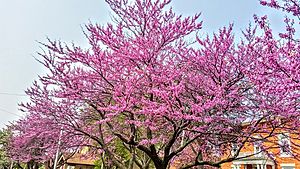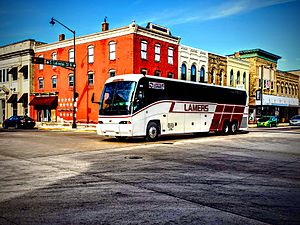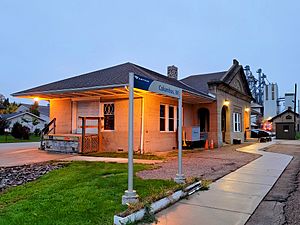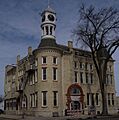Columbus, Wisconsin facts for kids
Quick facts for kids
Columbus, Wisconsin
|
|
|---|---|
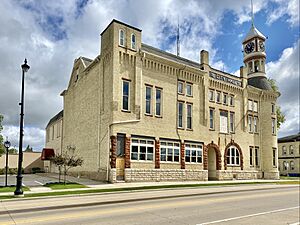
Columbus City Hall
|
|
| Nickname(s):
"Red Bud City"
|
|

Location of Columbus in Columbia and Dodge counties, Wisconsin
|
|
| Country | |
| State | |
| Counties | Columbia, Dodge |
| Area | |
| • Total | 4.59 sq mi (11.89 km2) |
| • Land | 4.55 sq mi (11.79 km2) |
| • Water | 0.04 sq mi (0.1 km2) |
| Elevation | 879 ft (268 m) |
| Population
(2020)
|
|
| • Total | 5,540 |
| • Density | 1,124.53/sq mi (434.2/km2) |
| Time zone | UTC-6 (Central) |
| • Summer (DST) | UTC-5 (Central) |
| Zip Code |
53925
|
| Area code(s) | 920 |
| FIPS code | 55-16450 |
| GNIS feature ID | 1583005 |
| Website | www.cityofcolumbuswi.com |
Columbus is a city located in Wisconsin, a state in the United States. It sits in both Columbia and Dodge counties. In 2020, about 5,540 people lived there.
Columbus is found northeast of Madison, a larger city. It's close to the Crawfish River. Most of Columbus is in Columbia County, but a small part is in Dodge County.
Contents
History of Columbus
Columbus has an interesting past. In 1845, H. A. Whitney from Vermont built the first store here. This building was also a tavern, a place to stay, and the first post office. Whitney was the first postmaster.
In 1857, the original building burned down. A new one, the Whitney Hotel, was built in 1858. This new hotel had a large ballroom on its third floor. People held dances and parties there.
Over the years, the Whitney Hotel changed. In the 1950s, it had a restaurant and bar. But by the 1990s, the building was in bad shape. It was almost torn down!
Luckily, local citizens and a group called the Columbus Downtown Development Corporation worked together. They saved the Whitney building and restored it. Today, it offers affordable homes for families and shops for local businesses.
Geography and Location
Columbus is located at coordinates 43.337366 degrees North and -89.022753 degrees West.
The city covers a total area of about 4.59 square miles (11.89 square kilometers). Most of this area is land, with a small part being water.
Population and People
| Historical population | |||
|---|---|---|---|
| Census | Pop. | %± | |
| 1850 | 288 | — | |
| 1860 | 892 | 209.7% | |
| 1870 | 1,888 | 111.7% | |
| 1880 | 1,876 | −0.6% | |
| 1890 | 1,977 | 5.4% | |
| 1900 | 2,349 | 18.8% | |
| 1910 | 2,523 | 7.4% | |
| 1920 | 2,460 | −2.5% | |
| 1930 | 2,514 | 2.2% | |
| 1940 | 2,760 | 9.8% | |
| 1950 | 3,250 | 17.8% | |
| 1960 | 3,467 | 6.7% | |
| 1970 | 3,789 | 9.3% | |
| 1980 | 4,049 | 6.9% | |
| 1990 | 4,093 | 1.1% | |
| 2000 | 4,479 | 9.4% | |
| 2010 | 4,991 | 11.4% | |
| 2020 | 5,540 | 11.0% | |
| U.S. Decennial Census | |||
The population of Columbus has grown steadily over the years. In 1900, there were 2,349 people. By 2020, the population had more than doubled to 5,540 residents.
Columbus in 2020
In 2020, Columbus had 5,540 people living there. The city had about 1,217 people per square mile. There were 2,444 homes in the city.
Most people in Columbus (about 90.5%) are White. About 5.2% of the population is Hispanic or Latino. Other groups like Black, Asian, and Native American people also live in Columbus.
The average household income in Columbus was around $65,029. Most adults (94.4%) have finished high school. Also, 36.1% of adults have a college degree or higher.
Arts and Culture
Columbus is known for its annual Redbud Festival. This festival happens in May, usually around Mother's Day. During the festival, the community celebrates the blooming of the special "Columbus Wisconsin Strain" of the redbud tree.
The festival includes fun activities like food, music, and enjoying the beautiful trees.
- Christopher Columbus Museum
- Farmers and Merchants Union Bank
The Farmers and Merchants Union Bank is a famous building. It was designed by a well-known architect named Louis Sullivan. This bank was even featured in the 2009 movie Public Enemies, starring Johnny Depp.
Historic Buildings to See
Columbus has many old and important buildings. Here are some of them:
- Adolphus and Sarah Ingalsbe House
- Albert M. and Alice Bellack House
- Amtrak station (built in 1906)
- Chapel Street Water Tower
- Columbus City Hall
- Columbus Fireman's Park Complex
- Columbus Post Office
- Columbus Public Library
- E. Clarke and Julia Arnold House
- F. A. Chadbourn House
- Farmers and Merchants Union Bank
- Frances Kurth Sharrow House
- Fred and Lucia Farnham House
- George Griswold House
- Gov. James T. Lewis House
- Holsten Family Farmstead
- John A. and Maggie Jones House
- Kurth Brewery
- Reinhard and Amelia Schendel House
- Whitney Hotel Building
- Zion Evangelical Lutheran Church and Parsonage
Education in Columbus
Students in Columbus attend schools run by the Columbus School District. The district has an elementary school, an intermediate school, a middle school, and a high school.
- Columbus Elementary School (Kindergarten to 2nd grade)
- Columbus Intermediate School (3rd to 5th grade)
- Columbus Middle School (6th to 8th grade)
- Columbus High School (9th to 12th grade)
Other schools in Columbus include:
- St. Jerome Catholic School (Kindergarten to 8th grade)
- Zion Lutheran School (Kindergarten to 8th grade)
- Wisconsin Academy (9th to 12th grade)
Transportation
Columbus is easy to reach by road. US 151 runs through the city. This highway connects Columbus to bigger cities like Madison and Fond du Lac. There are three exits on US 151 that lead into Columbus.
Several state highways also serve Columbus:
- Wis 16 goes towards Portage and Watertown.
- Wis 60 heads to Lodi and Hustiford.
- Wis 73 runs south to Marshall and north to Randolph.
- Wis 89 goes south to Waterloo and Fort Atkinson.
Columbus also has an Amtrak train station. Two daily trains, the Empire Builder and the Borealis, stop here. These trains connect Columbus to major cities like Chicago, Portland, Seattle, and Saint Paul. Freight trains also use the tracks, operated by the Soo Line Railroad.
For bus travel, Lamers Bus Service connects Columbus to Madison.
Notable People from Columbus
- Michael Adams, a state representative
- Charles L. Dering, a state senator
- Francis Fagan, a brave Navy Cross recipient
- Harmon J. Fisk, a state representative
- William M. Griswold, a state senator
- Joshua James Guppey, a Union Army general
- William Jones, a state representative
- Frank Lange, a major league baseball player
- James T. Lewis, a governor of Wisconsin
- Lewis Ludington, an early settler of Columbus
- Heather Miller, an Olympic athlete
- Peter Morris, a major league baseball player
- William Penterman, a state representative
- Bob Poser, a major league baseball player
- Frederick J. Stare, a nutritionist
- Samuel R. Webster, a state representative
- Russel R. Weisensel, a state representative
- E. W. Ziebarth, a radio broadcaster
Images for kids
-
Columbus, Wisconsin before the storm Columbus Downtown Historic District
-
Downtown Columbus on Highway 60/16 - a portion of the Columbus Downtown Historic District
-
A portion of the Dix Street-Warner Street Historic District
-
A portion of the Holsten Family Farmstead
-
A house within the South Dickason Boulevard Residential Historic District
See also
 In Spanish: Columbus (Wisconsin) para niños
In Spanish: Columbus (Wisconsin) para niños


